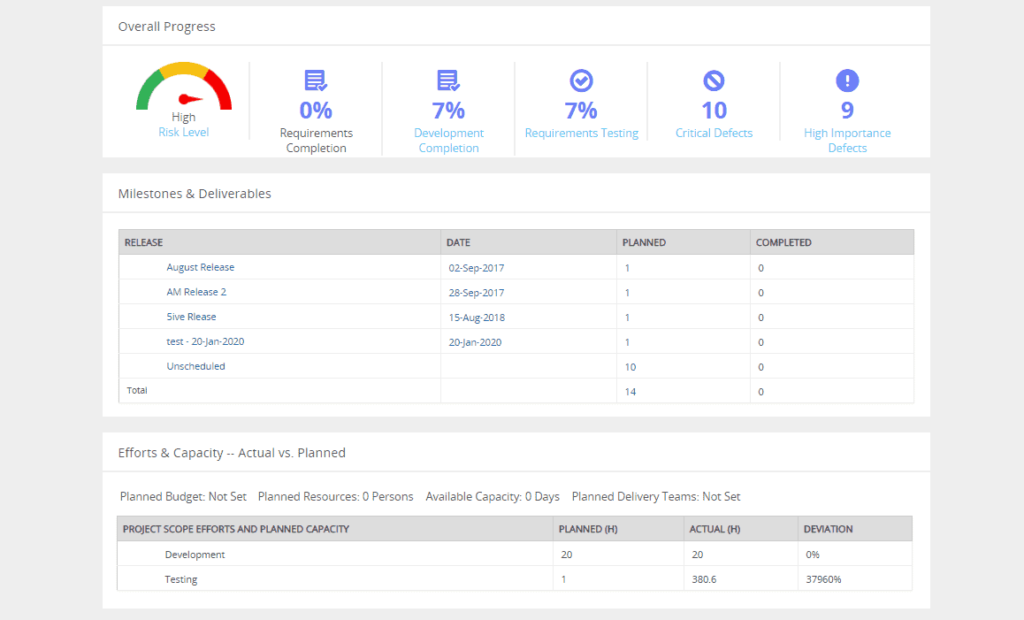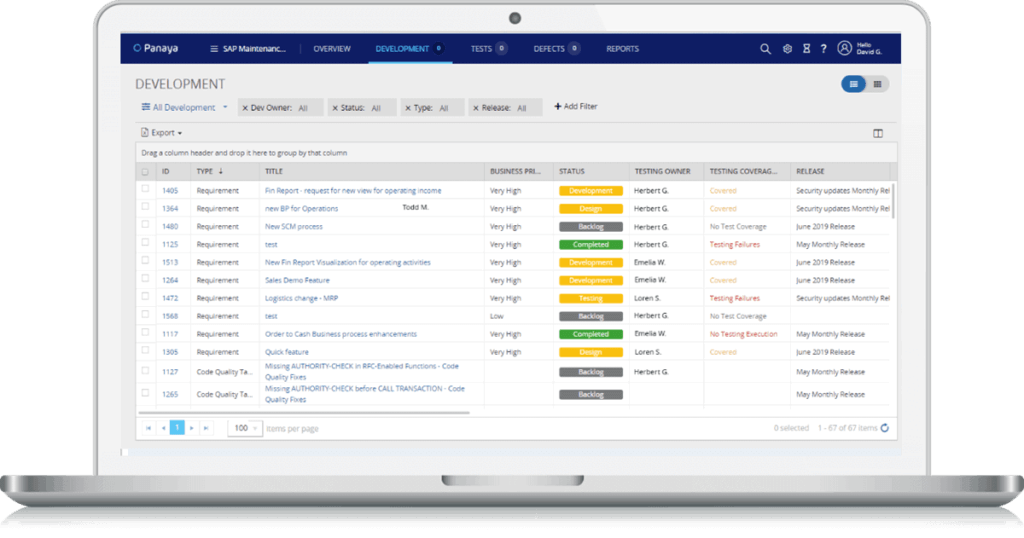

You can never put your company’s Release Management Process under too much scrutiny.
Any weaknesses along the lines will result in software that the end-user will not be happy with and may even reject.
That’s why so many organizations have invested in adding agile components to this essential enterprise process.
Before you rush to do the same, though, let’s talk about what your Release Management Process absolutely must entail and how one vital tool can help make it agile.
Simply put, Release Management is a process that entails the management, planning, scheduling, and controlling of an entire software build through every stage and environment involved, including testing and deploying software releases.

Although this is a relatively new discipline in terms of software engineering, it is also one that is rapidly expanding. Software systems, resources, and software development processes are becoming more and more distributed, which makes it inevitable that they also take on greater amounts of complexity and require specialization.
Of course, with the abundance of web applications, much of release management often focuses on the ongoing development, testing, and releases of these apps. Often, this includes running them on platforms that are constantly evolving and growing in complexity.
These types of systems demand dedicated resources in order to oversee the flow and integration of development, testing, releasing, and ongoing support.
Release lifecycle management is a very similar concept. It covers a broader understanding of the release management process, though. In fact, it may even cover areas that aren’t directly concerned with release and deployment management at all.
For the most part, release lifecycle management begins by looking at when the release is initially given a name and runs until the name is no longer used.
As an example, the “XYZ marketing release” may begin with planning before – even long before – any kind of code is checked or even remotely worked on.
Nonetheless, it still needs to be tracked right now. Release and deployment management windows must be acknowledged on the calendar. The necessary resources have to be applied.
The list goes on and on.
To be fair, it will also differ based on your team’s unique approach and the nature of the software on which you’re working.
Whatever the case, your team’s infrastructure should be designed so that it supports the release management lifecycle from the moment the start point is defined to the point that is designated as the end.
Likewise, change management and release management are also very similar – related, even – but not the same thing. It’s important that you don’t confuse the two or you’ll find your release management process needlessly suffering.
As you already know, release activities refer to things like:
On the other hand, the same high-level view of change activities would encompass things like:
The release management process is primarily concerned with providing a project with its schedule and plans for execution.
Change management – generally by way of a change approval board – is focused on authorizing changes to controlled environments.
Let’s take a more in-depth look at both to better explore how they differ.
For the most part, your change management protocols should be designed for transitioning brand new initiatives and procedural adjustments, bringing them from development processes into operations.
The main objective of your change management process should be to standardize the methods your team will use and the procedures you’ll follow for efficient and timely handling of every single change.
We’ll cover standardization in more detail a bit later.
By standardizing these efforts, you’ll be able to minimize the potential effects any change-related incidents may otherwise have on service quality. Doing so will also improve your organization’s day-to-day operations.
Within your configuration management database, it’s the change management process that will govern and introduce changes to the CIs (configuration items) that are part of your company’s live-production environment or any others that fall under change control.
Generally, IT operations are responsible for operating and protecting staging and production environments via change control. However, this responsibility usually ends with production environments.
Release management is chiefly concerned with how changes flow through any pre-production environments.
The ultimate goal is to ensure that this occurs and eventually results in the successful release and deployment of these changes into the production IT environment while causing as little disruption as possible.
Series of changes are grouped together, which are referred to as “releases.” These groupings are based on defined common characteristics among the changes in the group.
Release management seeks to create a more proactive and predictable change management process. It is absolutely essential for managing the volume of interdependent changes within a company.
Preproduction environments fall outside an IT operation’s parameters for change management controls. This would include examples like:
Due to the velocity with which these types of environments usually change during building and testing, it’s essential that you find the right balance between agility, control, and flexibility.
Typically, it is the project or release manager who selects the guidelines for managing these pre-production environments.
The release management process flow is fairly straightforward, though it can be broken down into numerous subsections.
Here is how the flow looks for introducing changes into your IT environment:
The release management process flow needs to be overseen by a manager, though they may decide to delegate some amount of their duties to subordinates.
This is usually the case when the scope of the project begins to swell.
Nonetheless, the job of the release manager typically encompasses the following duties:
Being a release manager means working through all kinds of challenges. Many of them are unique to the particular project, but the three that occur the most are:
Without managing the risks involved with these challenges, a manager can easily sabotage their own release management process.
Far too often, the temptation for release managers is to stay completely focused on the routines they institute.
Instead, they should visualize the quality and scope of their releases using dashboards and reports across multiple project waves down to the requirements for reaching completion status.
Real-time risk analysis and smart test plan validation can be used to optimize test resources and lower incident rates in production.
Providing statuses in real-time to all stakeholders involved will produce faster turnaround times without as much compromise.
Now that we are all working from the same definition of a release management process, let’s look at how we can improve yours so that it offers a much greater degree of agility.
There are three main requirements for doing so:
No matter what kind of business practice you’re looking to improve, the first place to begin is with standardizing its governance. This is especially true when it comes to your release management process, though, where it’s so important that your workflows and compliances will all adhere to Q-gate standards.
The great thing about standardization is that it makes automation possible. Wherever you can, you want to utilize automation throughout your release management process.
By doing so, you’ll not only see savings (both in terms of time and money), but you can also expect fewer mistakes as platforms aren’t at risk of human error. Of course, this also frees up your people to focus on the release-related tasks that demand their unique skills in order to be accomplished.
As an example, a company that lacks standardization may struggle with an engineering team that manually crafts their deployable packages.
Unfortunately, this means that the new package may not be the same as the one before it. It might not even work correctly. This can cause all kinds of problems, not the least of which is an unnecessary delay that holds up the rest of the lifecycle.
The good news is that an effective solution doesn’t have to be unnecessarily complex. You can simply create criteria for structure and acceptance for the package in question. These criteria must be met before the package can be deployed.
Obviously, if you add automation to the mix, you’ll have even fewer problems to worry about going forward. As a result, you’ll be able to go through packaging, versioning, testing, and deploying of finished code with one simple command in an extremely short amount of time.
As time goes on, your team can even execute regression tests with each development cycle to find even more ways to improve by implementing greater amounts of governance.
One of the most important tenets of agile is the need to constantly monitor a project and provide reports about its progress. Otherwise, you could invest a lot of time and money into an imperative project only to learn later that you missed the mark.
As you may already know, an agile project is broken down into sprints. Each of these requires at least one objective, though it might have two or more. At the end of a sprint, any progress that was made is judged against those objectives.
Completed vs. Committed Stories:
Always compare how many stories you committed to during sprint planning with the number identified as completed during your sprint review. This will make it easier for your team to better estimate its capabilities going forward.
Technical Debt Management:
You can measure this a few different ways, but it usually involves the number of bugs found. Other known problems may also be included depending on your project.
Team Velocity:
From one sprint to the next, you want to know how consistent your team is being. One easy way to do this is by comparing completed story points in the current sprint with those completed in previous sprints.
Communication:
Open and honest communication is vital between the scrum master, product owner, members of your team, stakeholders, and customers. You need to pay close attention to ensure this is happening and step in immediately if it isn’t.
Adherence to Best Practices:
This isn’t just about scrum rules, though those are certainly important. You should also be monitoring to ensure that your team is keeping to engineering best practices, as well.
Everyone’s Understanding of the Scope and Goal:
Although there’s no doubt that it’s a subjective measurement (similar to monitoring for honest communication), it’s a good idea to check in and see how well your product and development teams and the customer understand the sprint stories and goal.
The latter is typically aligned with the desired customer value that’s intended for continuous delivery and is objectively defined in the stories’ acceptance criteria.
The best way to determine this is with day-to-day contact and interactions with the team. Processing customer feedback will help, too.
As we already covered, standardization will improve your release process management immensely. While automation may not always be an option, creating and implementing standards will help with each of the above areas.

Requirements traceability is the systematic linkage that makes it possible to follow business requirements and their related fulfillment and validation. This includes following it backwards as well as forwards.
For example, you can begin following business requirements starting all the way back at their origins. You can follow them all the way through development processes and specification and continue doing so to their subsequent release and deployment. If you continue, you can reach their point of use and even to ongoing refinement.
This will certainly prove helpful to do, but if you attempt it manually, you’ll find that this help comes at a significant price. The labor-intensive process may even prove to be too cost-prohibitive to consider. As with automation, this is another example of a part of your release process management process that would undoubtedly benefit from a high-quality platform like ours.
The results will certainly be worth it. Imagine finding out that a set of tests have all of a sudden begun creating problems. Thanks to traceability that exists between the tests and their related requirements, you’ll have no problem identifying the affected function or features.
By combining the three processes discussed above with real-time information regarding quality, scope, and time, release management process managers are able to make informed decisions before going into production.
Let’s look at a use case example in order to better highlight how common problems can be solved using our Release Dynamix (RDx) solution. It was designed to help organizations to drive great innovations by supporting the continuous delivery of business-driven changes with improved speed and simplicity.
In this use case, there are two main challenges.
For this use case, the transformational goals were:
Here are the 11 different RDx features and the transformation paths they provide in their respective areas:
We designed Release Dynamix (RDx) specifically to remove the complexity and bottlenecks that almost always hinder important changes from taking place. As a result, any enterprise, no matter how large, can easily become agile.
It prioritizes a collaborative environment but not one that is solely meant to facilitate cooperation between developers. RDx will also foster collaborative efforts between all stakeholders in your release management process.
This means your organization can consistently release high-quality changes rapidly. You’ll consistently meet the expectations of your users and drive your business forward.
Your Release Management Process is too intricate to leave completely in human hands. Even if it weren’t, you’d still be taking on unnecessary risks by not properly auditing it to find ways you could improve.
Fortunately, this doesn’t have to mean a massive investment of either time or money. As you just saw from the above example, RDx is a release management tool that can manage your entire application change process, from creation all the way to validation.
To finally begin leveraging Agile in your enterprise-level release management process, start with a demo of RDx. You’ll soon find that every step of your process becomes more Agile, something that will make your customers and your team much happier.
What are the key components of an effective release management process?
The lifecycle of release management is made up of 5 steps, which are planning, building, testing, preparing, and deploying a software update. These stages are each vital to ensure your organization can arrange a successful release.
What are the biggest challenges faced by release managers, and how can they be addressed?
Clear communication is one of the greatest challenges, without which there can be delays. To deal with this, release managers can set regular meetings and offer clear documentation to make sure all team members are updated.
What are some recommended Agile Key Performance Indicators (KPIs) for monitoring team progress in release management?
KPIs in Agile usually cover cycle & lead time, throughput, work in progress, work item age, flow efficiency and blocked time, among others. Progress is measured by the completion of each stage, which helps teams improve their processes and deliver high-quality products.